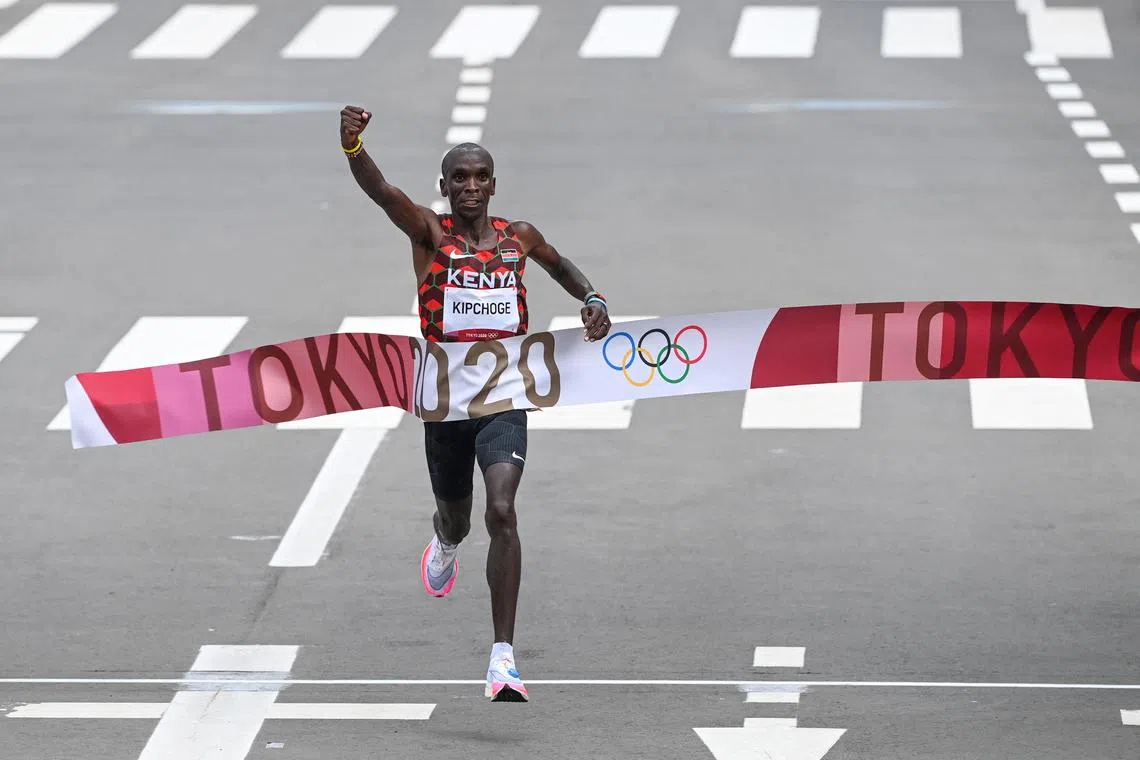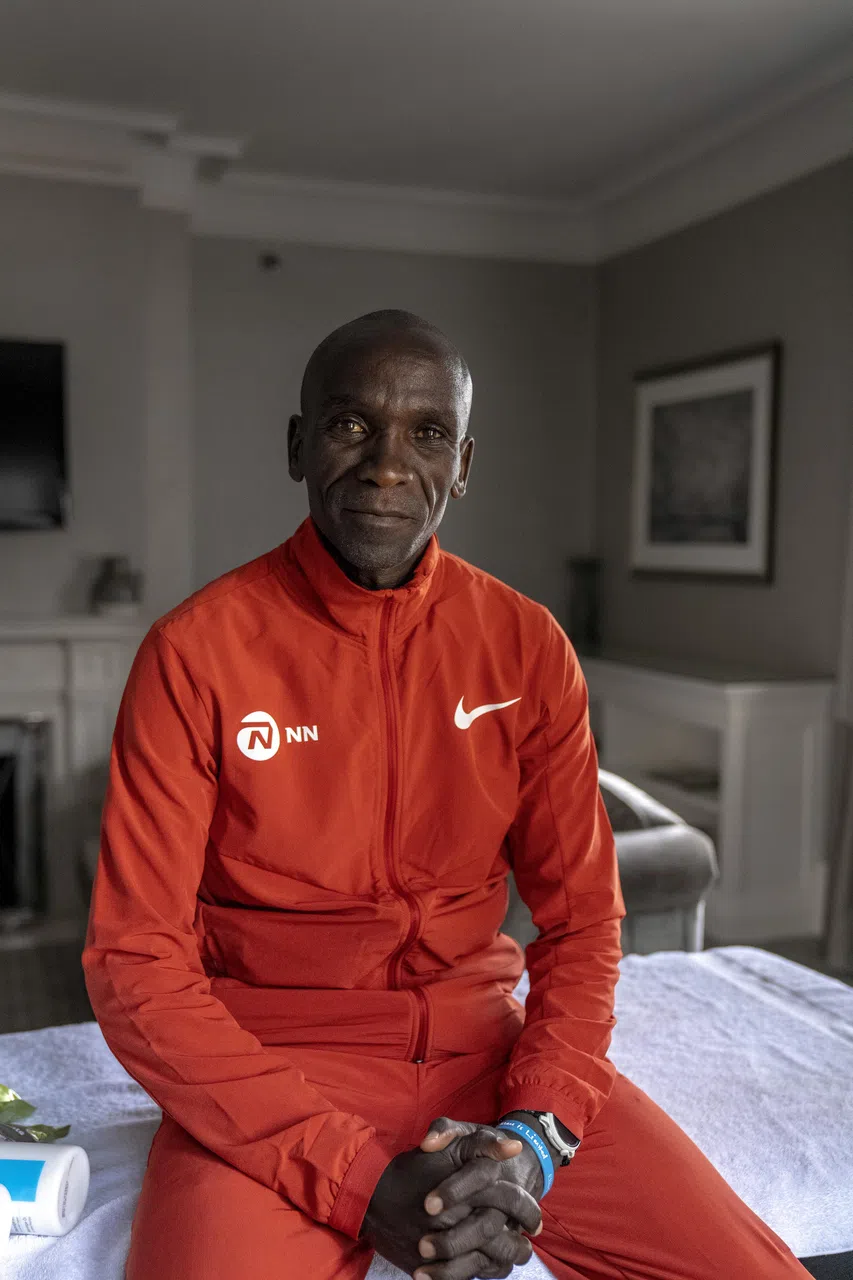How fast is Kenyan marathoner Eliud Kipchoge? You’ll fall down when you find out
Sign up now: Get ST's newsletters delivered to your inbox

Kenya's Eliud Kipchoge crosses the finish line to win the marathon final during the Tokyo 2020 Olympic Games in Sapporo.
PHOTO: AFP
Follow topic:
BOSTON – Some numbers are difficult to comprehend. The human body, for example, is made up of about 40 trillion cells. Earth is about 150 million kilometres from the sun, give or take.
And Eliud Kipchoge has run a marathon in 2hr 1min 9sec.
Anyone remotely familiar with the marathon – and all 42.195km of its muscle-searing masochism – can appreciate that the Kenyan’s world record for the distance, which he set last September when he won the Berlin Marathon for the fourth time,
But how fast, exactly?
Well, you could head to your neighbourhood track and try to run a 400m loop in about 69 seconds – and run an additional 104 laps at that pace.
But perhaps the most inventive way to contextualise Kipchoge’s marathon tempo comes via an enormous treadmill, equipped with flexible matting and carbon fibre rods, which was originally designed for use on television game shows and for film stunt work.
It is called the Tumbleator, and Kipchoge, who will tackle the Boston Marathon for the first time on Monday, described himself as a fan.
“I think it’s a great motivation for the human family,” he said in an interview in March from Kenya, where he was training.
“It’s good for people to run on it and feel it and get the experience. It’s a positive thing.”
The Tumbleator, which is about 1.8m wide and 6m long, made its debut at a running exposition ahead of the 2017 London Marathon where anyone could take on the challenge of running 400m at a “world-class marathon pace”, according to Canning Conveyor, the British company that built the contraption.
That worked out to about 20.9kmh, a sprint for most mortals.
The fallout was literal and predictable – the Tumbleator welcomed weekend warriors onto its springy surface before spitting most of them out the back as it ramped up its speed, sending them into the safe embrace of padded gymnastic mats.

Eliud Kipchoge (left) watching people try to stay up on the Tumbleator.
PHOTO: NYTIMES
The giant treadmill was not originally associated with one particular athlete, but it did not take long for it to be tied to Kipchoge, 38, for the simple reason that he was faster than everyone else.
He first shattered the world record at the 2018 Berlin Marathon when he finished in 2:01:39.
A few weeks later, the Tumbleator was unveiled for the first time at the Chicago Marathon, where a batch of runners got a first-hand feel for Kipchoge’s pace – for 200m, which was long enough.
What does that pace feel like to the man himself, out on the open road?
“I think I can say that I enjoy that pace,” Kipchoge said. “My training is enough to go at that pace.”
The Tumbleator, which spends most of its time in Europe, will make its next public appearance at the London Marathon on Sunday.
The power of the marathon, and what separates it from so many other sporting events, is its communal feel, said Danny Coyle, the head of digital and social media for the Abbott World Marathon Majors.
Most humans will never play in a World Series, drive a Formula One car or compete on Centre Court at Wimbledon.
“But when you do a marathon, you run the same (42.195km) as the best athletes on the planet,” Coyle said.
Indeed, on Monday, Kipchoge will warm up the Boston Marathon route
And the Tumbleator, in its own cartoonish way, has offered an additional avenue for amateur athletes to bridge the gap between themselves and elites like Kipchoge, albeit for 20 or 30 seconds tops.
“And it just looks fun, right?” Coyle said. “Who doesn’t love a giant treadmill?”
The siren song of the Tumbleator was irresistible to Mo Farah before his appearance at the 2019 London Marathon. A four-time Olympic champion, Farah tumbled – twice.
“Even some of the best in the world can struggle on the Tumbleator,” Coyle added.
A few days later, Kipchoge went on to win the race. Farah finished in fifth place.

Eliud Kipchoge is running the Boston Marathon for the first time on Monday.
PHOTO: NYTIMES
It should be noted that Kipchoge was not born a champion.
As a child in Kapsisiywa, a small village in Kenya, he ran back and forth to school. As a teenager, he helped support his family by collecting milk from neighbours and selling it at a market.
A more formal introduction to running came at age 16, when Patrick Sang, an Olympic silver medallist in the steeplechase, returned to Kenya to organise sports events.
Kipchoge soon became a protege. Sang, 59, has remained his coach.
At 18, Kipchoge won a world championship in the 5,000m. He followed that with a pair of Olympic medals in the event, winning bronze in 2004 and silver in 2008. He transitioned to the marathon in 2013.
He has since owned the event, winning 10 World Marathon Majors and 15 of the 17 marathons he has entered.
At the Tokyo Games held in 2021, he retained his 2016 Olympic title in dominant fashion. And in 2022, he broke his own world record by shaving 30 seconds from it.
He has officially clocked four of the six fastest marathons ever.
In October 2022, when Kipchoge got a chance to see the Tumbleator in action before the London Marathon, he wished participants luck in “trying out my new world-record pace”. More spills ensued.
“It’s good!” said Kipchoge, who often speaks as if every sentence should be punctuated by an exclamation point.
“For someone to fall, that’s a challenge! That means they need to work more.”
But the man who has become synonymous with the Tumbleator seldom runs on a treadmill.
“I prefer to be outside,” he said. NYTIMES

